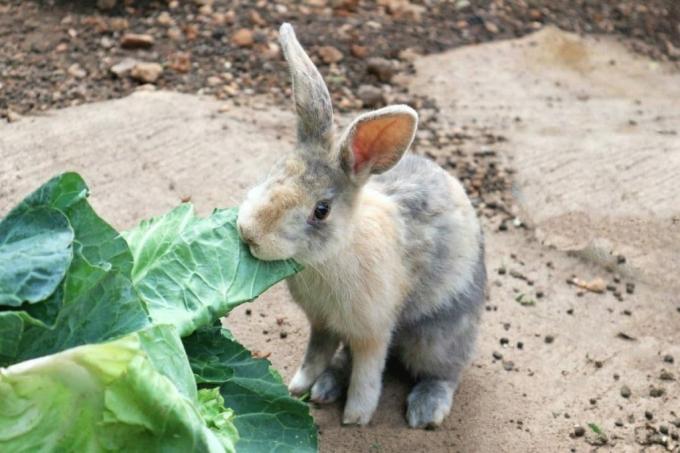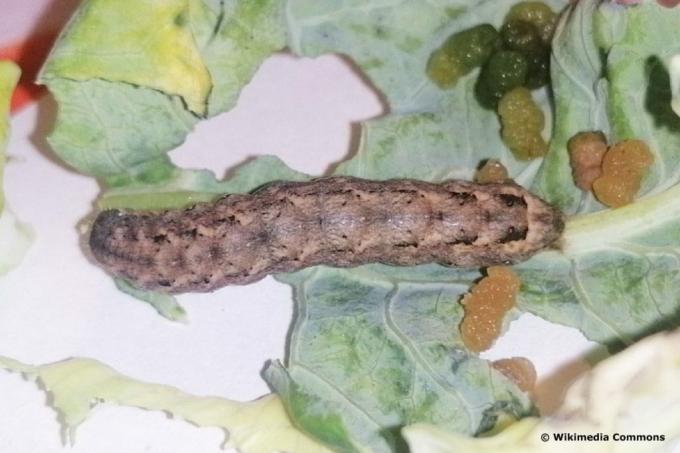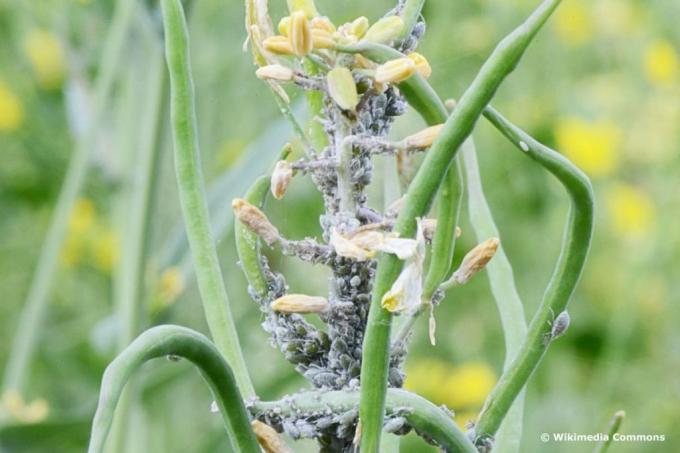
table of contents
- cauliflower
- Cauliflower Leaves Eaten: The Most Common culprits
- Great Cabbage White butterfly (Pieris brassica)
- Hares and rabbits
- Small cabbage white butterfly (Pieris rapae)
- Cabbage heart mosquito (Contarinia nasturtii)
- Cabbage Flea (Phyllotreta undulata)
- Coal Owl (Mamestra brassicae)
- Cabbage moth (Plutella xylostella)
- Cabbage moth scale louse (Aleyrodes proletella)
- Mealy cabbage aphid (Brevicoryne brassicae)
- Birds
- frequently asked Questions
The tasty cauliflower is a must for many hobby gardeners Vegetable garden. Unfortunately, it is also high on the menu with pests and cauliflower leaves are often eaten. Read here who has a particularly strong appetite for cabbage and what you can do about it.
In a nutshell
- Cauliflower leaves are eaten by various pests
- Pests are sometimes difficult to detect (size, hidden in the cauliflower)
- Prevention is often more effective than fighting
cauliflower
Cauliflower (Brassica oleracea var. Botrytis) is a cultivar of the vegetable cabbage. While with other types of cabbage the leaves are consumed, with this variety the close together flower sprouts come on the table. Therefore, cauliflower is a flower vegetable. In addition to the ivory-colored heads, there are also purple and yellow-green variants.
Note: In Austria the cauliflower is called "cauliflower".
Cauliflower Leaves Eaten: The Most Common culprits
Cabbage plants are popular foods for animals and insects. If the leaves of the cauliflower are eaten, larvae and caterpillars are particularly suitable. Below is a list of the most common pests. This is how you recognize and combat them.
Great Cabbage White butterfly (Pieris brassica)
Pest and damage pattern
- Pest: caterpillars of the butterfly
- Pitting to skeleton corrosion on the leaves
- Egg clutch on the underside of the leaf

Appear
- First generation butterflies at the end of April
- 2. Generation of caterpillars from July to September
Appearance
- Butterflies: yellowish-white, black border towards the front, wingspan about five centimeters
- Caterpillars: up to four centimeters long, yellowish with black spots
measures
- Safety nets
- Collecting
- Spread plant broths (e.g. B. Tansy or wormwood)
Hares and rabbits
Damage image
- Hearts or leaf parts are eaten away
- prefer young plants

Appear
- throughout the season
Fight
- no special measures
Small cabbage white butterfly (Pieris rapae)
Pest and damage pattern
- Pest: caterpillars of the butterfly
- Cauliflower leaves: pitting
- It is possible to eat the flowers
- eggs deposited individually on the leaves

Appear
- Caterpillars from the end of May
Appearance
- Butterfly: Butterfly, white wings with black point
- Caterpillars: up to 25 millimeters long, light to pale green; fine, velvety hair
measures
- Safety nets
- Collecting
- Spread plant broths (e.g. B. Tansy or wormwood)
Cabbage heart mosquito (Contarinia nasturtii)
Pest and damage pattern
- Pest: larvae of the gnat
- Twists, corks and / or deformities on the leaves
- Heartlessness (destruction of the vegetation point); increased formation of side shoots
- Damage to the flower: damage to the main and lateral axes; crippled, scabbed heads

Source: Rasbak, Draaihartigheid bij bloemkool (Contarinia nasturtii damage on cauliflower), Edited by Plantopedia, CC BY-SA 3.0
Appearance
- Larvae: up to two millimeters in size, transparent to yellowish. Footless
- Mosquitoes: up to 2 millimeters in size, reddish-brown, hardly visible to the naked eye
Appear
- Mosquitoes appear from the beginning of May
- Egg laying at temperatures above 15 degrees Celsius
- Larvae hatch after three to five days
- develop particularly well in wet weather periods
- up to five generations per year
- Pest infestation throughout the season
measures
- Adjust crop rotation
- wind-protected locations
- Sticky traps against flying mosquitoes (pheromone trap)
- Culture protection nets (mesh size less than one millimeter)
Cabbage Flea (Phyllotreta undulata)
Damage image
- The beetles' feeding marks
- Scraping damage: mostly round holes, later extensive
- prefers seedlings and young plants
Appear
- from the end of April until the summer
- Beginning of feeding from a temperature of about 20 degrees Celsius
- 2. Generation from June / July

Source: This image is created by user Wim Rubers at waarneming.nl, a source of nature observations in the Netherlands., Phyllotreta undulata, Edited by Plantopedia, CC BY 3.0
Appearance
- beetles up to three millimeters in size
- shiny black
- sometimes with thick, yellow stripes on the back
- Jump movements of up to 40 centimeters are possible
Countermeasures
- cause unrest (e.g. by regularly sweeping the plants), beetles flee and often do not find their way back
- Keep soil moist (beetles prefer dryness)
- Loosen the soil surface (beetles don't like rough soil)
Coal Owl (Mamestra brassicae)
Pest and damage pattern
- Caterpillars of the owl moth
- strong traces of eating on leaves, flowers are also being eaten
- Pollution from caterpillar droppings
Appear
- flies in two generations
- First generation of butterflies hatch from May to July
- first generation of caterpillars from Mail until the end of July
- second generation of caterpillars from mid-August to late October

Source: Danilo.penic, M.brassicae2, Edited by Plantopedia, CC BY-SA 4.0
Appearance
- Moth: gray-brown wings, wave-like pattern on the front wings, wingspan four to five centimeters
- Caterpillars: up to five centimeters long, first greenish, later brown, light yellow stripes on the sides
Fight
- Culture protection nets
- Collecting
Cabbage moth (Plutella xylostella)
Damage image
- Larvae eat their leaves
- Scrape corrosion on the underside of the leaf (window corrosion)
- partly also pitting corrosion
- skeletal damage in the case of severe infestation
- Soiling of the flowers by caterpillar droppings
Appear
- throughout the season
- First generation butterflies at the end of April / beginning of May
- first generation of caterpillars from the end of May (eats three to four weeks)
- second generation of butterflies from mid-July, third from August
- third generation of caterpillars overwinters in the ground as a pupa

Source: Rasbak, Koolmot zijkant Plutella xylostella op boerenkool (Curly kale), Edited by Plantopedia, CC BY-SA 3.0
Appearance
- Cabbage moth: dark brown moth with yellowish wavy stripes on the wings; Wingspan about 1.5 centimeters
- Larvae: pale green with black dots, slightly hairy, can develop web threads ("rope up and down")
Fight
- Nets against butterflies
- Caterpillars: collecting
Cabbage moth scale louse (Aleyrodes proletella)
Damage image
- sits sucking on the underside of cauliflower leaves
- Whole flocks fly up when the plant is touched
- ring or circular oviposition on the underside of the leaf
- Honeydew
- attracts sooty mildew
- deprive the leaves of the ability to photosynthesize
Appear
- Late summer and autumn

Appearance
- about 1.3 millimeters tall
- white powder-coated wings
measures
In the case of cauliflower, control of the so-called "whitefly" is usually not necessary. However, if the infestation is very severe, you should react.
Mealy cabbage aphid (Brevicoryne brassicae)
Damage image
- Damage to suction especially on young leaves
- Loss of green color (white discoloration), deformation (curling of the leaves)
- Heartlessness possible
- Aphid excretions at infested sites (honeydew)
Appear
- throughout the season
- preferred: warm and dry weather
- up to ten generations possible
- Population highs: July / August and September / October

Source: Rasbak, Melige koolluis op koolzaad, Brevicoryne brassicae on rapeseed, Edited by Plantopedia, CC BY-SA 3.0
Appearance
- green-gray or blue-white powdered aphids
measure
- Use of parasitic wasps (natural predators)
Tip: Hosing down with water when the lice are on the leaves can also help against the aphids.
Birds
Among the birds, wood pigeons in particular eat the cauliflower leaves. But it also counts crows, sparrows and Blackbirds to the cauliflower-eaters.

Damage image
- pitted edges of the cauliflower leaves
- small pieces of leaf on the ground
Appear
- throughout the season
- prefers feeding on young plants
measure
- Bird protection nets
frequently asked Questions
If you want to resort to the chemical club, you should find out which products are approved for home and allotment gardens.
Yes, but the pests then often attack other types of vegetables that are also eaten.
In the case of severe infestation, this is entirely possible. You should therefore recognize a pest infestation quickly so that you can take countermeasures.



